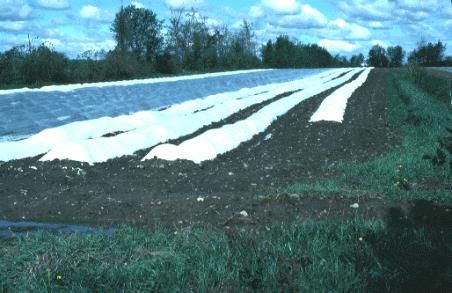Cool temperatures play a large role in the uncertainty of vegetable production in Florida. Production seasons should progress in timely fashion up the peninsula. However, cool temperatures can slow development of crops such that seasons in different regions overlap. This problem can be more serious in northern Florida when cool temperatures cause overlapping with more northernly states.
Production systems that moderate temperature and protect from cold winds can provide for more consistent crop timing and even earlier harvest. Plastic mulch is one technique that can be used to secure earlier yields. Another tool for growth enhancement is row covers. Row covers are flexible, transparent, or semitransparent materials used to enclose single or multiple rows of plants with the objective of moderating temperature and protecting from wind.
Temperature Moderation
There are basically two types of row covers for commercial use: polyethylene, and porous, floating, nonwoven materials. Polyethylene is usually employed as a tunnel on wire hoops (Figure 1). Clear polyethylene provides increased temperatures by the greenhouse effect. Clear tunnels usually increase temperatures too much for most days during the spring in Florida, so the tunnels need to be ventilated by perforating the plastic. White polyethylene can provide some growth enhancement while avoiding the extremely high temperatures in the tunnel.

Credit: UF/IFAS
Nonwoven covers are fabric-like and can be placed over rows in tunnel fashion or can be laid on the crop in floating fashion.
Row cover use should be planned so that benefit from temperature moderation results. Row covers should be removed soon after flowering begins for insect-pollinated crops or before temperature increases too much. Economics of row cover use must be evaluated by the grower. Row covers will cost about $1000 to $1500 per acre, but most materials can be used for at least two or more seasons. More information on use of row covers in Florida can be found in Circ. 728 Row Covers for Commercial Vegetable Culture in Florida https://edis.ifas.ufl.edu/cv201.
Frost Protection
Protecting crops from frost and freezes has been a continual challenge for vegetable growers in Florida. Several options are available including sprinkler irrigation, soil banking, and crop covers. Each method has application in certain areas for certain crops.
Young crops can be protected from frost by covering with soil. This is used commonly for potatoes which have large energy reserves in the seed piece to grow out from the soil covering. Other crops would need to be physically uncovered. Early sweet corn or beans can be planted in a small trench in which the seedlings are protected from frost by the warm surrounding soil mass.
Sprinkler irrigation protects crops from freezing by providing the heat of fusion to the plant. As water freezes, it gives up the latent heat of fusion to warm the leaves. As long as water is continually applied in ample quantity, the plant will be protected. Sprinkler irrigation is less effective under windy conditions. Irrigation systems must be able to supply large quantities of water and must not be prone to breakdown. Diesel pumps should be used for this purpose since electric pumps are prone to power outages. Problems with sprinkler irrigation for frost protection include large water requirements, expensive capital outlay, possible ice and water damage to the crop, and soil erosion.
Row covers (crop covers) also can be used for frost and freeze protection (Figure 2). Depending on the thickness of the cover, protection to 25°F is possible. Nonwovern materials of 0.5 oz per yard will protect to about 30°F while materials in the 1.5 to 2.0 oz range will protect to about 25°F. Wire hoops can also be used over each row or bed to protect the crop from the physical abrasion of the row cover. Wire hoops under the cover also maximizes the protection from cold damage. Row covers are expensive to purchase but can be used for several seasons. Row covers do not have the problems associated with water as in sprinkler protection. Fruits and plants do not suffer water and ice damage and workers can enter fields readily.

Credit: UF/IFAS